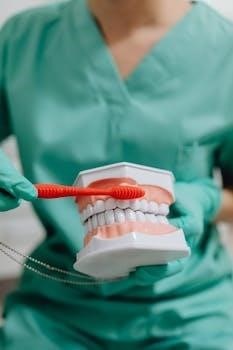ADA Dental Codes 2024 PDF⁚ An Overview
The American Dental Association (ADA) has updated its Code on Dental Procedures and Nomenclature (CDT) for 2024. This standardized language is crucial for effective communication within the dental healthcare industry. The updated codes ensure accurate reporting and billing for dental services‚ promoting clarity and consistency in dental practice management.
New and Revised Codes in CDT 2024
The CDT 2024 update introduces notable changes to dental coding practices. Specifically‚ there are 14 new codes that address emerging dental procedures and technologies. These additions reflect the evolving landscape of dental care‚ ensuring that practitioners can accurately document and bill for the latest treatments. Furthermore‚ the update includes two revised codes‚ which have been modified to provide greater clarity and precision in their descriptions.
One significant addition is a new category of service dedicated to sleep apnea‚ highlighting the growing recognition of the dentist’s role in managing this condition. The absence of deleted codes ensures continuity in coding practices‚ minimizing disruption for dental professionals. These changes are vital for maintaining accurate records and facilitating seamless communication between dentists‚ patients‚ and insurance providers.
By incorporating these new and revised codes‚ the CDT 2024 update promotes standardization and efficiency in dental billing and documentation. Dental practices must familiarize themselves with these changes to ensure compliance and optimize their revenue cycle management. Staying informed about the latest coding updates is essential for providing high-quality dental care and maintaining financial stability.

Accessing the Updated Codes
Dental professionals can access the updated CDT 2024 codes through various channels. One primary resource is the American Dental Association (ADA) website‚ where the full code set is available for purchase in PDF format. This allows for easy searching and referencing of specific codes. Delta Dental also provides access to the updated codes through their secure provider portal. By logging into their account‚ dentists can view the latest code changes and policy revisions.
Additionally‚ third-party dental coding software and applications often incorporate the updated CDT codes. These tools streamline the coding process and help ensure accuracy in claim submissions. Many professional dental organizations also offer training and resources on the new codes. These educational opportunities can help dental teams stay up-to-date with the latest changes and best practices.
Staying informed about how to access and utilize the updated codes is crucial for accurate billing. Regular consultation of official resources and participation in continuing education will help ensure compliance.
CDT Code as a Standardized Language
The Current Dental Terminology (CDT) code serves as a standardized language‚ which facilitates effective communication among dentists‚ insurance carriers‚ and other members of the healthcare industry. Developed by the American Dental Association (ADA)‚ the CDT code provides a uniform system for describing dental procedures and services. This standardization ensures clarity and consistency in dental claim submissions‚ reducing ambiguities and misunderstandings.
The use of CDT codes streamlines administrative processes. It also promotes accurate data collection for research and analysis. As a HIPAA-approved code set‚ the CDT code plays a vital role in maintaining patient privacy and security. Its annual updates reflect advancements in dental techniques and technologies‚ ensuring that the code remains current and relevant. By adhering to the CDT code‚ dental professionals contribute to a more efficient and transparent healthcare system.
This standardized approach minimizes errors and facilitates seamless communication‚ benefiting all stakeholders involved in dental care delivery and reimbursement.
Delta Dental and CDT 2024 Codes
Delta Dental utilizes the American Dental Association’s (ADA) Current Dental Terminology (CDT) codes for processing dental claims. For services performed on or after January 1‚ 2024‚ it is imperative to use the CDT 2024 codes when submitting claims to Delta Dental. These codes ensure accurate and efficient processing of claims‚ preventing delays or rejections.
Delta Dental emphasizes the importance of using the most accurate procedure code available within the CDT 2024 nomenclature. The presence of a code in CDT does not automatically guarantee coverage for a subscriber. Always verify patient eligibility and coverage details before providing treatment. Delta Dental provides resources for providers to stay updated on coding changes and policy revisions. Accessing your secure provider account on deltadentalco.com is recommended for viewing updated codes.
Adherence to these guidelines ensures smooth claims processing and accurate reimbursement for dental services rendered to Delta Dental members. By staying informed about the latest CDT updates‚ dental professionals can optimize their billing practices and maintain compliance with Delta Dental’s requirements;
The Number of CDT Procedure Codes in 2024
The American Dental Association (ADA) maintains a comprehensive list of codes for dental procedures and nomenclature‚ known as the CDT codes. In the year 2024‚ the CDT code set includes a total of 814 procedure codes. This extensive list covers a wide range of dental services‚ from diagnostic and preventive procedures to restorative‚ endodontic‚ periodontal‚ and surgical treatments.
Dental professionals rely on these codes to accurately document and bill for the services they provide. The availability of 814 codes in CDT 2024 allows for precise selection of the most appropriate code for each specific procedure performed. This level of detail is crucial for ensuring accurate claims processing‚ proper reimbursement‚ and effective communication among dentists‚ insurance companies‚ and patients.
Staying up-to-date with the latest CDT code set is essential for all dental practitioners. The ADA releases annual updates to the CDT codes to reflect advancements in dental techniques‚ materials‚ and technology. By utilizing the correct CDT codes‚ dental professionals can maintain compliance with industry standards and optimize their practice management processes.

ADA Principles of Ethics and Code of Conduct
The American Dental Association (ADA) establishes a framework of ethical principles and a code of conduct that all member dentists are expected to uphold. This framework serves as a guide for ethical decision-making and professional behavior in the practice of dentistry. The ADA’s Principles of Ethics and Code of Conduct are rooted in the fundamental values of patient autonomy‚ beneficence‚ non-maleficence‚ justice‚ and veracity.
These principles guide dentists in providing quality care‚ respecting patient rights‚ and maintaining professional integrity. The ADA’s code of conduct outlines specific standards of conduct related to patient relations‚ professional representation‚ advertising‚ and financial arrangements. One key aspect of the code relates to accurate and truthful reporting of dental procedures.
The ADA emphasizes that dentists must accurately describe the services they provide‚ using the appropriate CDT codes. Misrepresentation of services‚ including incorrect coding‚ is considered unethical and can have serious consequences. Dentists are expected to adhere to the CDT guidelines and ensure that their coding practices align with the verbal descriptors of the procedures performed‚ upholding the integrity of the dental profession.

Relationship between SNODENT‚ ICD-10-CM‚ and CDT Codes
SNODENT‚ ICD-10-CM‚ and CDT codes represent distinct but interconnected coding systems within healthcare. CDT‚ or Current Dental Terminology‚ focuses on dental procedures and nomenclature‚ providing a standardized language for dentists to report services. ICD-10-CM‚ or International Classification of Diseases‚ Tenth Revision‚ Clinical Modification‚ is used to classify and code diagnoses and medical conditions‚ offering a comprehensive system for reporting diseases.
SNODENT‚ or Systematized Nomenclature of Dentistry‚ provides a structured vocabulary for describing dental findings‚ diseases‚ and procedures. The relationship between these coding systems is crucial for comprehensive patient care and data analysis. A two-way map connects SNODENT concepts for dental-related disorders to ICD-10-CM disease classification codes‚ facilitating a link between dental findings and systemic health conditions.
Furthermore‚ a three-way map connects SNODENT and ICD-10-CM pairs to relevant CDT procedure codes. This integration allows for a holistic view of patient care‚ linking diagnoses‚ findings‚ and procedures. This interconnectedness supports research‚ data analysis‚ and improved communication among healthcare professionals‚ ultimately enhancing patient outcomes by providing a more complete understanding of the patient’s overall health status.

General Policies Related to Procedure Codes
General policies related to procedure codes provide essential guidelines for accurate coding and claim submission. These policies‚ preceding each category code listing‚ establish the framework for appropriate code selection and usage. Adhering to these general policies is crucial for ensuring compliance and avoiding claim denials. They encompass various aspects of coding‚ including the scope of each code category and limitations.
Furthermore‚ general policies address the proper use of modifiers‚ which provide additional information about the procedure performed. These modifiers clarify circumstances impacting the service‚ such as multiple procedures or unusual complexity. Understanding these policies is vital for accurate representation of dental services rendered. Policies for specific procedure codes are detailed within each category after the codes and nomenclature.
These specific policies often provide further clarification on the appropriate use of individual codes. Dentists should consult both the general and specific policies to ensure accurate and compliant coding practices. Consistent adherence to these guidelines promotes transparency‚ reduces errors‚ and facilitates efficient claim processing‚ contributing to the overall integrity of the dental billing system and fostering trust between providers and payers.
ADA Dental Claim Form Completion Instructions 2024
The American Dental Association (ADA) provides comprehensive completion instructions for the dental claim form‚ updated for 2024. These instructions are essential for ensuring accurate and efficient claim submission to payers like Delta Dental. The ADA’s Council on Dental Benefit Programs is responsible for the content and instructions‚ available electronically and in paper format.
The guide aligns with the latest edition of the ADA Current Dental Terminology (CDT) procedure codes. Using CDT 2024 codes for services performed on or after January 1‚ 2024‚ is crucial. The instructions cover all sections of the claim form‚ detailing required information for each field. This includes patient demographics‚ provider information‚ and accurate procedure coding based on the CDT manual.
The ADA emphasizes consistent coding with CDT verbal descriptors. While payers accept only coding consistent with CDT‚ code presence doesn’t guarantee coverage. The instructions guide proper use of qualifiers and attachments‚ supporting the claim’s validity. Adhering to these instructions minimizes errors‚ reduces claim denials‚ and streamlines the reimbursement process‚ ensuring timely payments for dental services rendered.

